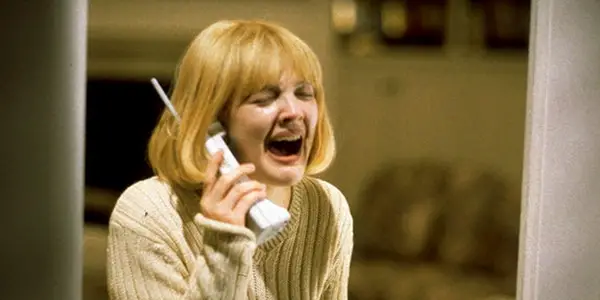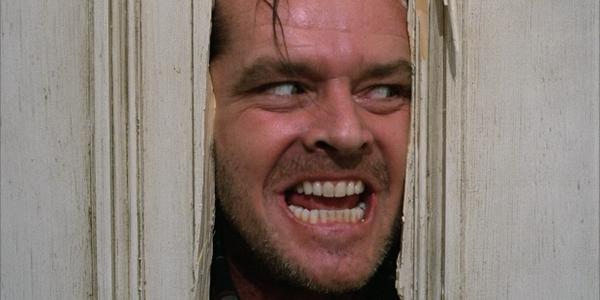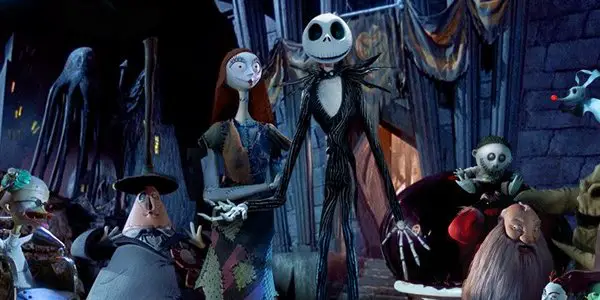Film Inquiry’s Films Of Halloween

Stephanie Archer is 39 year old film fanatic living in…
Halloween – the season of ghouls, screams and tricks or treats. It’s the time of year when scares of all kinds are acceptable and even welcomed. We become the creatures of the night, in search for something to satisfy our yearly holiday craving. For many people, it is the thrill and joy of catching their favorite films of Halloween.
For this Halloween Season, several of Film Inquiry’s writers got together to share their top ten films of the Halloween Season. The films submitted are an amazing representation of a season we all have loved since childhood. So read on and enjoy!
Stephanie Archer: Scream (1996, Wes Craven)

Scream was released on December 20, 1996 to immediate success. Sitting in class the Monday following its release, I heard a recap of the entire film – all the gory slasher scenes in particular. I remember wanting to see the film that EVERYONE was seeing, yet this was a film I would have to wait a few years to be old enough to see. Finally old enough to see what everyone had been raving about, I caught it on a television broadcast and was not disappointed.
Scream, written by Kevin Williamson and directed by horror legend Wes Craven, follows the story of Sidney Prescot (played by Neve Campbell), a local Woodsboro teen trying to cope with the untimely death of her mother. As the anniversary of her murder draws closer, her classmates start to fall victim to the mysterious Ghostface – leading up to an epic conclusion that not everyone survives.
One of the things I loved the most about Scream was its ability to not only honor successful horror films that came before, but also make fun of the horror genre and itself. Freddy Krueger, Candyman, Halloween and Psycho are just a few of the nods that are beautifully placed throughout the film – whether it be visually or verbally. Yet, while these tributes are a beautiful enhancement, it’s the ability to make fun that really stands out. Chicks running upstairs instead of out the door and “The Rules to Surviving a Horror Movie” are constantly referenced, mocking the behaviors consistently used within a horror film – and are inevitably put into play within the film itself.
Scream has been my favorite for years, and a permanent staple of my Halloween season!
(The Rest of Stephanie’s Top 10: Scream 2, A Nightmare on Elm Street, The Nightmare Before Christmas, Young Frankenstein, Interview With a Vampire, Hocus Pocus, Saw, Scream 4, I Know What You Did Last Summer)
Robert Gallacher: Halloween (1978, John Carpenter)

John Carpenter’s 1978 slasher classic is, for me at least, the scariest film of all time. It’s instantly terrifying, from those infamous opening minutes in which the camera adopts the point-of-view of the killer as they break into the house on Halloween night and stabs a young woman to death, only for the camera to then pull back and reveal the killer to be a six year old Michael Myers who has just murdered his sister.
Fifteen years later, Myers has escaped from the mental asylum in time for Halloween and is all set to claim more innocent victims. His main target is high school student Laurie Strode, played by a young Jamie Lee Curtis – daughter of Psycho shower victim Janet Leigh – making her onscreen debut.
Carpenter expertly builds an eerie and unnerving mood through his masterful use of camerawork and music to represent Myer’s increasing stalking of Laurie. At the same time, screen veteran Donald Pleasance turns in a memorable performance as Michael’s psychiatrist, who desperately seeks to recapture his murderous patient before the inevitable devastating consequences occur.
Halloween was a major career breakthrough for Carpenter, who not only wrote and directed but also composed the film’s chilling main musical theme. The famous Myers mask was actually a William Shatner mask painted white; and it is this lack of any visible facial expressions, combined with his infinite silence, that makes Michael Myers the most terrifying serial killer in all of cinema – not even hiding in the closet will save you here.
(The rest of Robert’s Top 10: The Shining , Repulsion , The Exorcist, Psycho, Eyes Without a Face, Don’t Look Now, The Texas Chainsaw Massacre , Les Diaboliques , Night of the Living Dead)
Laura Birnbaum: The Blair Witch Project (1999, Daniel Myrick)

There are few folkloric concepts as terrifying to me as a malevolent presence in the woods.
It is easy to conjure up images of shadowy figures and haggard witches emerging from gnarled trees, but what if the entity we imagine is never to be seen, or further, what if the unseen creature is far more frightening than we imagined? In The Blair Witch Project, three student filmmakers unintentionally evoke a hidden spirit as they fight to survive through its haunting and ever-changing landscape in this minimalist exploration into terror.
What might now seem like a worn out genre trope parodied to exhaustion was once an effective and novel form of storytelling. The film employed one of the best viral marketing campaigns of all time through the use of low-budget trailers and a website (that still exists today), which believably suggests the idea that the footage had been “found” in the woods – audiences bought it.
Even now, with the definite assurance of its fabrication, the fictional value of this film still resonates and haunts me with its sense of realism. To highlight the authenticity of the found footage, the filmmakers and actors exercised a kind of “rogue” filmmaking that involved fully immersing the consenting actors in the woods under the pretense that they would react to stimuli. With a basic premise and gear in hand, the three actors willingly entered the woods “alone” and responded accordingly – snotty nose and all.
The Blair Witch Project’s strength is in the implicit presence of something “out there”. As the years have passed, the witch becomes allegorical to the tumultuous and dichotomous connectivity between man and nature and the will to survive despite it. It is a film that utilizes what isn’t in the frame to coerce and manipulate you into constructing a monster of your own making. Because after all, what you don’t see might just have very clear sight of you.
(The rest of Laura’s Top 10: The Blackcoat’s Daughter, The Haunting, Session 9, House of the Devil, The Witch, The Sixth Sense, Psycho, The Exorcist, The Ring)
Dave Fontana: Psycho (1960, Alfred Hitchc*ck)

Alfred Hitchc*ck’s best films are those that skew with expectations. Vertigo, for example, begins as a supernatural mystery thriller before shifting to an unsettling psychological character study. In Psycho, the thriller element at the start is much the same, before also completely changing gears about halfway through. The film concerns a woman named Marion Crane (Janet Leigh), who has just run off with $40,000 from her job as a real estate secretary. She then happens to end up at the worst possible mother-son housing development, the Bates Motel.
Psycho works precisely because of Hitchc*ck’s direction (in addition to Bernard Herrmann’s gyrating and unrelenting score). The story it is based on, a novel by Robert Bloch, was partly based on the Ed Gein murder case. Yet Hitchc*ck strove to make it more akin to a B-horror monster movie, which were currently all the rage on the horror market of the 1950s. If only I could have seen audiences’ first reactions during the iconic shower scene, a cinematic moment that will forever be idolized and imitated.
Norman Bates (Anthony Perkins) is one of cinema’s most compelling villains due to his oddly fitting boyish demeanor. Monsters in the horror genre were typically ugly, hellish creatures, such as Frankenstein or the Wolf Man, but Norman Bates appears to have all the despicable qualities of a bouquet of flowers. As a contrast, the adorably awkward initial interaction he has with Marion is juxtaposed only minutes later with his erratic, homicidal alter-ego. Who else but Hitchc*ck could make a monster out of that innocent-looking face?
Psycho has endured as a landmark in horror for all these reasons and more. It is a heart-pounding thriller, a thought-provoking look into the mind of a serial killer, and in addition is considered to be the birth of the slasher sub-genre. Its influence can be seen in countless films that followed, from John Carpenter’s Halloween to Wes Craven‘s Scream. It’s actually quite difficult to find a modern horror film that doesn’t at least pay a slight homage to Hitchc*ck‘s masterpiece.
(The rest of Dave’s Top 10: Alien, Suspiria, The Thing, Halloween, A Nightmare on Elm Street, Nosferatu, Black Sunday, Scream, The Witch)
Mike Daringer: The Shining (1980, Stanley Kubrick)

When it comes to the jeepers creepers of Halloween, there’s nothing that gets in my blood more than Stanley Kubrick‘s unfaithful adaptation of Stephen King‘s novel, The Shining.
Because technology wasn’t up to snuff, Kubrick ditched all of the fantastical elements in the book in favor of that which is the most truly terrifying, the unknown and unconscious mind. It could’ve been a laughable affair had Kubrick dare try to bring topiary to life in the early ’80s. But instead, The Shining transplants horror that manifests in the physical world back to the invisible spectrum of dark imagination.
It’s easy to say that the movie is merely about abuse, mental health, or addiction. But there is so much more going on. It’s similar to 2001: A Space Odyssey in that both films take Ancient Greek legends and modernize them. It has the meta component of being titled “illumination”, and that those who get what the film is striving for are metaphysically enlightened beings, i.e. they shine.
But there’s also a privy to seeing things we aren’t supposed to. Ironically enough, while most horror films are shrouded in dark sets and lighting, The Shining opens up the world with huge shafts of light and set dressing. It highlights and acknowledges the grand conceit, again. What we imagine to be around the corners is far more unsettling than jump scares or darkly lit corridors. Everything is illuminated and, brother, is it a horror quite unspeakable.
We can dress up the horror with stories that are logical to keep our ethos safe. But in the end, the truth is that our corruption is always in us, has always been with us, and we cannot out run our hellish and destructive nature. See?
(The rest of Mike’s Top 10: Psycho, Alien, A Nightmare on Elm Street, The Thing, Evil Dead 2, Shaun of the Dead, The Cabin in the Woods, Nosferatu, The Exorcist)
Alex Lines: The Nightmare Before Christmas (1993, Henry Selick)

The Nightmare Before Christmas is a terrific film which has been taken in completely by mainstream pop culture, with the initial film being lost in a sea of merchandising and refigured pop culture iconography. Directed by animation director Henry Selick, (often misconstrued as being directed by Tim Burton, who only created the initial idea and some of the character designs), who defines the film as a Christmas film rather than Halloween, as within the heart of the film lies in celebration of the holiday, not in revelling in the Halloween setting. Despite this, the film is filled to the brim with rich Halloween visuals, giving the macabre holiday a cheerful and family-friendly spin.
In Halloween Town, the place in charge of making sure Halloween happens, the current ‘Pumpkin King’, Jack Skellington (voiced by Fright Night‘s Chris Sarandon and music sung by composer Danny Elfman) is getting quite sick of the Halloween holiday. Secretly wanting to make people happy rather than scare them, he wanders off and accidentally finds the land of Christmas Town, a bright and cheery place where Santa and his townsfolk reside. Wanting to bring Christmas to all, Skellington takes it upon himself to spread Christmas cheer, whilst being tracked down by his enemy Oogie Boogie (voiced by Ken Page), who has decided to kidnap Santa Claus to finally end Christmas.
The Nightmare Before Christmas has endeared and has become a Christmas/Halloween classic for a variety of reasons. The film’s genuine heart and catchy songs keeps the children entertained, with its striking visuals and impressive stop-motion animation providing enough material that will keep all ages happy. The unique character designs have had a large impact on pop culture, but, much like Saturday Night Fever, the film’s public perception is much different to the film that it’s based on. Saturday Night Fever is a film which demonises and criticises the disco movement, but the public image is that the film loves and celebrates the dance culture.
The Nightmare Before Christmas is seen as the gothic romance, with depressing overtones and macabre imagery. The film is much more goofy and lighthearted than people think, with the Halloween setting having people misconstrue the film as being a comically Gothic adventure. Selick does a great job in making this holiday film a classic, following it up with a solid line-up of different movies, including quirky comedy MonkeyBone and another dark stop-motion venture Coraline.
(The rest of Alex’s Top 10: The Monster Squad, Poltergeist, Halloween 3, Creepshow, V/H/S, WNUF Halloween Special, Dark Night of the Scarecrow, Murder Party, Trick R Treat)
Armando Dela Cruz: Kairo (2001, Kiyoshi Kurosawa)

Isolationism is the fear that fuels Kairo (Eng. title: Pulse), Kiyoshi Kurosawa’s 2001 techno-thriller centered on a succession of grim suicides in a damp, dreary town in Tokyo, Japan. Very few have mastered the art of cinematic fright, and with this, along with a few more of his works (Cure and Seance are the first ones that come to mind), Kurosawa proves his skill and austerity as a filmmaker.
The film dissipates a sense of disconnect, rendered ironic at the face of crucial advancements in technology, one so jarring that it makes the experience too terrifying to endure. In the film, a strange force pushes people in the throes of fatal sorrow and solitude – perhaps the worst way to go. Kurosawa’s monster here, therefore, is neither an all-knowing artificial consciousness nor a Frankensteinian mech-droid that will inevitably push mankind into obsolescence. It is humanity itself – a traitor for its many tipping points, an enemy seemingly impossible to vanquish.
(The rest of Armando’s Top 10: Begotten, Hour of the Wolf, Let the Right One In, Under the Skin, Halloween, Hausu (House), Thirst, Eyes Without A Face, Suspiria)
Julia Smith: Ghostwatch (1992, Lesley Manning)

The year was 1992, it was the week before Halloween and my parents were buying a new TV. In the store, TVs played an advert for a BBC Halloween event called Ghostwatch, which would see our favourite presenters spend the night in a haunted house. A few days later, we were enjoying Halloween with my cousins and someone turned the show on. I was a huge scaredy cat as a kid and I barely saw five minutes before I was scared off. My mother later reassured me that it was all made up, but it was way too late for my malleable brain.
Later in life, I discovered that Ghostwatch was a Orson Welles’ War Of The Worlds affair, a fictional story masquerading as fact to give the public a good scare. The story was that two young sisters were being haunted by a vicious ghost and the BBC was investigating. I ended up watching it in full as a 20-year-old film student and it still did a terrific job of frightening me.
I’ve watched the film again in recent years and I see exactly why it had such a profound effect on me. The girls were the same ages as me and my sister, they had the same wallpaper in their bedroom as me, and the same posters on the wall. The reporter, Sarah Greene, presented children’s television; I trusted her! Ghostwatch taught me the importance of subjectivity, and it showed me how we relate to the people on screen. But most importantly, it showed me the irrevocable effect TV and film can have on a person, and as damaged as I was by it, I still can’t thank it enough for the influence it continues to have on me.
(The rest of Julia’s Top 10: Hocus Pocus, Halloween, The Woman In Black, House Of Wax, The Others, The Haunting, The House On Haunted Hill, Paranormal Activity, The Evil Dead)
“What’s Your Favorite Scary Movie”? Let us know your favorite Halloween film in the comments below!
Does content like this matter to you?
Become a Member and support film journalism. Unlock access to all of Film Inquiry`s great articles. Join a community of like-minded readers who are passionate about cinema - get access to our private members Network, give back to independent filmmakers, and more.













